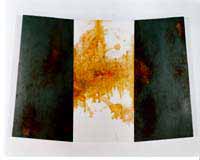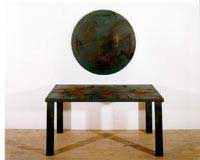Biography
1941 Born
in Taishan County, Guangdong Province, China
1950 Moved to Hong Kong
1972 Immigrated to Canada
Selected
Solo Exbitions:
|
|
1996
|
"Premiere",
organized by Art Beatus Gallery, Hong Kong, Hong Kong Arts Centre.
|
|
1995
|
One
person show at studio 301, Water street, Vancouver.
|
|
1988
|
Yin
Koo Tsai Art Club, Vancouver.
|
|
1987
|
Richmond
Art Gallery, Richmond, British Columbia, Canada.
|
|
1986
|
University
of British Columbia Asian Centre, Vancouver, Canada.
|
|
1965
|
Exhibitions
of Chinese Printings by Tam Wah Nam, City Hall of Hong Kong.
|
|
|
|
Selected
Group Exhibitions:
|
|
1998
|
"Between
the Sky and the Earth", Annie Wong Art Foundation, University Museum and
Art Gallery, The University of Hong Kong.
|
|
1996
|
"A
Canadian Experience", Art Beatus, Vancouver, Canada
"Art
Forum", Berlin
|
|
1992
|
"Transposition",
Community Arts Council, Vancouver, Canada
|
|
1991
|
"Echoes
After the Storm-Tiananmen Square Memorial Exhibition", University of British
Columbia Asian Centre, Vancouver, Canada.
|
|
1990
|
"One
Art" Group Exhibitions, Hong Kong Arts Centre, Hong Kong.
|
|
1989
|
Beijing
Massacre Group Show, Robson Square Media Centre, Vancouver, Canada
"Beyond
the Magic Mountains", Hanart Gallery, New York, U.S.A.
|
|
1983
|
Chinese
Canada Visual Art Exhibition, Robson Square Media Centre, Vancouver.
|
|
1965
|
Chinese
Painting, Harvard University, M.I.T., Boston, U.S.A.
|
|
1964
|
Exhibition
at the Folkwang Museum, West Germany
|
|
1963
|
Exhibition
of Contemporary Chinese Paintings, organized by the American Academy of
Chinese Culture, San Francisco, U.S.A.
|
Statement about the artist:
|
An
Explorer of Cultures by Ian Findlay Brown
Frank Tam has made his home in Vancouver, where he has grappled with the
subtleties of his art which is an attempt to integrate two very distinct
pictorial, cultural, and philosophical traditions. One tradition is suffused
with the eloquent, intellectual, and nature inspired legacies of Chinese
ink painting, while the other is firmly rooted in aggressive independent,
yet equally intellectual, Western abstract art practices. In striving
to bring together Eastern and Western art sensibilities and their unique
concerns, Tam is in no way seeking to champion one art form over the other.
What he is clearly endeavoring to do is to combine the pictorial and spiritual
, the painterly and the philosophical qualities of both to create a fresh
visual sensibility.
In Harmony 1 (1995) the bold wash and calligraphic stroke of his lotus
paintings has given way to a dense minimalist tendency, broken only by
his introduction of figurative elements. The crusty side panels of both
Harmony I and Harmony II have the feeling of old iron plate left to the
vagaries of weather where it will disintegrate, the surface changing with
the elements. This process is a revealing one as it changes the original
surface slowly to reveal the interior. Each new scar reveals the soul
of such work much in the same way the Chinese artist's brush reveals the
spirit of the scene upon which he gazes. Looked at closely the panels
could resemble, too, a distant landscape where mountains are being swallowed
by dark clouds. At another angle the panel can appear as brownish landmasses
seen from the air set amidst shadowy gray waters.
It is here that Tam's juxtapositions enliven the works and suggest a clearer
Chinese influence. The centre panel of Harmony 1 with its tumbling black
numbers at the bottom as if they were rocks reaching up to a golden sky,
hints at Chinese landscape, while the faded ghostly figure in the center
panel of Harmony 1 seems trapped in time. Tam is searching for a way not
only to be spontaneous in his practice, but also to reveal the balance
of nature and the artist. Tam is not intent on merely showing us the surface,
he wants to aid us in looking beyond it and into the spirit of his subject.
Excerpts taken from Asian Art News Nov/Dec Issue, 1996
|
Collections:
Museum of Civilization, Ottawa, Canada
Hong Kong Museum of Art
Annie Wong Art Foundation
Private collection in Canada.
For
further information, please contact:
Canada: tel: (1) 604.688.2633, fax: (1)
604.688.2685
|



